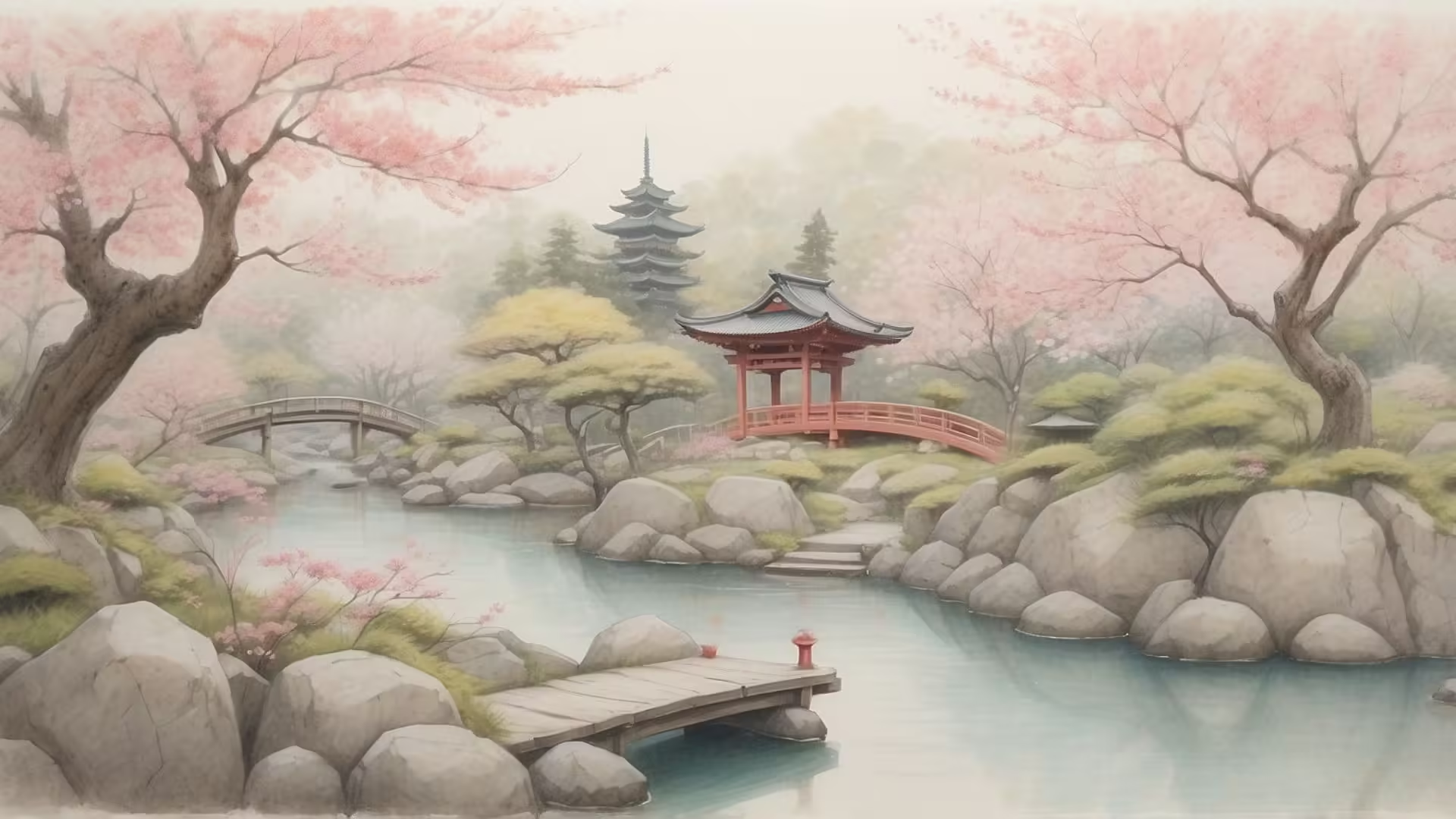The Makioka Sisters, originally published as Sasameyuki in the 1940s, is regarded as one of Junichiro Tanizaki’s masterpieces. Set in the years leading up to World War II, the novel offers a portrait of the lives of four sisters from a once-wealthy Osaka family. Through the lens of these sisters’ personal struggles, the story examines the complex interplay between tradition and modernity, privilege and decline, and family obligation and personal freedom. Tanizaki’s narrative is slow and deliberate, focusing on the details of everyday life while subtly hinting at the profound shifts happening beneath the surface of Japanese society.
The Plot: A Family at a Crossroads
The novel centers around the Makioka family, whose fortunes and social standing have declined since the death of their parents. The family’s primary concern is to secure a marriage for the third sister, Yukiko, whose unmarried status reflects poorly on the family’s reputation. Her two older sisters, Tsuruko and Sachiko, are already married, but their lives are far from ideal. Meanwhile, the youngest sister, Taeko, is eager to break free from the family’s constraints and embrace a modern, independent lifestyle.
As the story unfolds, the sisters grapple with personal dilemmas and shifting societal norms. Yukiko’s repeated failed marriage negotiations create tension, reflecting the pressure women faced to conform to family expectations. Taeko’s rebellious behavior further complicates matters, as her choices threaten to tarnish the family name. Through these characters, Tanizaki paints a nuanced picture of the challenges that arise when tradition clashes with personal freedom.
Themes of Tradition, Change, and Identity
At its core, The Makioka Sisters explores the tension between preserving tradition and embracing change. The older sisters, Tsuruko and Yukiko, are tied to the family’s traditional values, while Taeko represents the desire for independence and modernity. Sachiko, caught between these two worlds, tries to maintain harmony, reflecting the struggle many individuals face when navigating cultural shifts.
The novel also delves into themes of identity and social class. The Makiokas’ declining wealth and status force them to confront the reality of their changing place in society. This decline mirrors the larger transformation happening in Japan at the time, as the old aristocratic ways gave way to modern ideals. Through the sisters’ experiences, Tanizaki offers a meditation on how identity is shaped by both internal desires and external expectations.
The Power of Everyday Moments
One of the most striking features of The Makioka Sisters is its attention to detail. Tanizaki’s narrative is rich with descriptions of everyday activities—seasonal festivals, tea ceremonies, and family dinners. These moments, though seemingly mundane, carry deep emotional weight, revealing the characters’ inner struggles and the unspoken dynamics between them. The slow pace of the novel allows readers to immerse themselves in the sisters’ world, experiencing the subtle shifts in their relationships and the gradual erosion of their traditions.
This focus on the ordinary also serves as a reminder that life’s most meaningful moments often happen in the quiet spaces between big events. The novel suggests that personal growth and change are not always marked by dramatic transformations but unfold gradually, like the changing of seasons.
A Reflection of Pre-War Japan
Tanizaki’s novel is as much a reflection of a specific historical moment as it is a family drama. Set in the years leading up to World War II, the story captures the unease and uncertainty of a society in transition. The Makioka family’s struggles reflect the larger cultural shifts taking place in Japan as Western influences began to challenge traditional norms. This historical backdrop adds depth to the narrative, making it not just a personal story but also a commentary on a nation at a crossroads.
The Legacy of The Makioka Sisters
More than 70 years after its publication, The Makioka Sisters remains a beloved classic, both in Japan and internationally. Its timeless themes of family, tradition, and personal freedom continue to resonate with readers today. The novel’s rich characterization and intricate storytelling have cemented its place as one of the great works of modern literature. Tanizaki’s ability to capture the complexity of human relationships and the nuances of cultural change ensures that The Makioka Sisters will continue to captivate readers for generations to come.
The Makioka Sisters is more than just a portrait of a family—it’s a meditation on the tension between past and present, tradition and change. Through the lives of its four protagonists, the novel explores universal themes that still resonate today. Whether you’re drawn to its richly detailed narrative, its exploration of identity and social expectations, or its subtle commentary on a society in transition, The Makioka Sisters offers a reading experience that is both profound and unforgettable.
Let’s Talk
There’s something quietly mesmerizing about The Makioka Sisters. It’s not the kind of novel with big plot twists or shocking revelations—it’s all in the little things. What really struck me was how Tanizaki captures the in-between moments of life—the pauses, the conversations that seem trivial but are actually loaded with unspoken emotions. It makes you think about how much of our own lives happen in those quiet spaces, where nothing and everything are happening at the same time. Have you ever had one of those moments, like sitting with someone in silence, and you know something important is being said, even though no one is talking?
One thing that keeps coming back to me is how the story reflects the tension between tradition and change. It’s not just about the sisters trying to navigate their roles in the family—it’s about how that struggle mirrors what happens in real life. Think about how we all deal with expectations, whether they come from family, society, or even ourselves. How much of what we do is because we want to, and how much of it is because we think we should? Yukiko, with her endless failed marriage negotiations, feels that pressure so deeply. It makes me wonder—how often do we feel trapped by the roles others assign to us, and how do we break free from them without losing ourselves?
And then there’s Taeko, the youngest sister, who’s trying so hard to live on her own terms. She’s drawn to modern life and independence, but it’s not as simple as saying goodbye to tradition. Isn’t that the tricky part? We want freedom, but breaking away from the past isn’t always as liberating as it seems. There’s a weight that comes with leaving behind what’s familiar, and Tanizaki doesn’t shy away from showing that. Have you ever chased after something you thought would make you happy, only to find it’s more complicated than you expected?
What I love about this story is how it doesn’t judge its characters. Each sister is doing the best she can within the limits of her world. Tsuruko clings to tradition, Sachiko tries to balance both worlds, Yukiko quietly endures, and Taeko pushes boundaries. It’s a reminder that there’s no one right way to live—only choices, and the consequences that come with them. And isn’t that a lesson we all learn at some point? Life is less about finding the “right” answer and more about figuring out which path feels truest to who we are.
The attention to detail in this novel is something else too. Tanizaki makes you feel the passing of seasons, the texture of the clothes, and the rhythm of daily routines. It’s almost meditative. It got me thinking about how much beauty there is in the ordinary—those small, everyday rituals we don’t usually pay attention to. When was the last time you really noticed the way light shifts in a room, or how a certain smell brings back a memory? There’s something grounding about that, isn’t there?
What’s really remarkable is how relevant the story still feels today. Sure, it’s set in pre-war Japan, but the themes are universal—family expectations, the struggle between tradition and change, the search for personal freedom. These are things we all deal with, whether we live in Osaka or anywhere else in the world. It’s funny how literature can do that—show us how much we have in common with people from different times and places.
So, what do you think? Which of the sisters resonates with you the most—are you more of a Taeko, pushing boundaries, or a Yukiko, navigating expectations with quiet strength? And how do you balance the pull of tradition with the desire for change in your own life? Because that’s the thing about stories like The Makioka Sisters—they don’t just make us think about the characters; they make us think about ourselves.
Let’s Learn Vocabulary in Context
Let’s explore some of the key vocabulary that came up in our discussion of The Makioka Sisters and see how these words apply to our everyday experiences. First up is “tradition.” Tradition is all about customs and practices passed down through generations. It’s like having a family recipe you cook every holiday, not because anyone really loves it, but because it’s just what you do. In the novel, the sisters struggle to maintain family traditions even as the world around them changes, which makes us think about how much of our own behavior is shaped by tradition. Ever found yourself following a tradition and thought, “Do I actually enjoy this, or am I just doing it out of habit?”
Next, we have “modernity.” Modernity refers to new ideas, lifestyles, and attitudes that challenge the old ways of thinking. Taeko embodies this in the story, embracing independence and freedom. In real life, modernity is what makes us swap handwritten letters for instant texts. It’s not always smooth sailing, though—sometimes modern ways clash with what we’re used to, and we end up feeling caught in between.
“Reputation” plays a big role in the novel too. Reputation is how others perceive you, and in both the story and real life, it can shape how people treat you. “She has a reputation for being reliable” is a compliment, but reputation can also be a burden—like when you feel pressured to live up to an image that doesn’t quite fit anymore. In the novel, Yukiko’s reputation as a quiet, obedient daughter weighs heavily on her, complicating her marriage prospects.
Another interesting word is “identity.” Identity is how we see ourselves and how we want others to see us. It’s tricky because identity can shift over time, and sometimes, other people’s expectations shape it in ways we don’t like. Have you ever found yourself acting a certain way just because people expect it, even though it doesn’t feel like “you” anymore? That’s the kind of identity struggle the sisters go through—trying to figure out who they are in a changing world.
“Obligation” is another word worth thinking about. Obligation refers to a duty or responsibility, often imposed by society or family. The Makioka sisters feel obligated to maintain the family’s honor and traditions, even when it goes against their personal desires. In everyday life, obligations show up in smaller ways—like feeling obligated to attend a family event when you’d rather stay home. It’s that constant push and pull between what we want to do and what we feel we should do.
Let’s talk about “expectations.” Expectations are assumptions about how things or people should be. The novel shows how expectations—especially those placed on women—can create pressure and frustration. Ever had someone expect you to be a certain way, and you just didn’t have the energy to meet their expectations? It’s exhausting, right?
Then there’s “freedom.” In the story, Taeko seeks freedom from the family’s traditional constraints, symbolizing the desire to live life on her own terms. But freedom isn’t always easy—it comes with risks and uncertainties. It’s like moving out of your parents’ house for the first time. You gain freedom, but suddenly you have to figure out how to pay bills and cook more than instant noodles.
“Decline” is another important word in the novel. The Makioka family’s decline in wealth and status mirrors the changes happening in society. In real life, decline shows up too—whether it’s a neighborhood losing its charm or a beloved restaurant closing down. Decline can be hard to accept, especially when it’s tied to something that once felt stable.
“Harmony” is a word we all aspire to but rarely achieve perfectly. In the novel, Sachiko tries to create harmony between her sisters, balancing tradition with change. In real life, harmony is when things just click—when work, relationships, and personal time all feel in sync. But let’s be honest: harmony is usually more of a fleeting moment than a permanent state.
Finally, we have “conflict.” Conflict isn’t just about fights; it’s any kind of struggle or disagreement, whether internal or external. The sisters experience conflict within themselves, with each other, and with the changing world around them. In real life, conflict can be as simple as debating what movie to watch with friends or as complex as figuring out what direction to take in your career.
Here are a couple of questions to think about: What’s a tradition or expectation that you’ve found difficult to let go of? And how do you handle the conflicts between what you want to do and what you feel obligated to do?










0 Comments